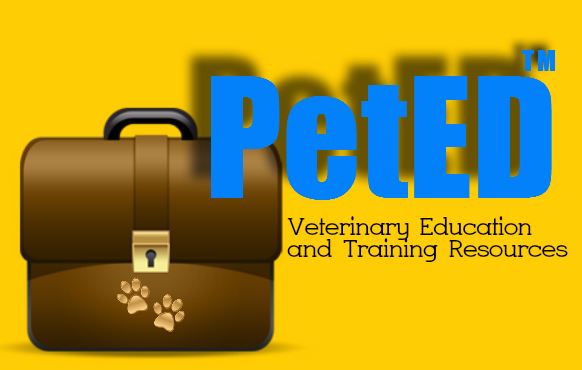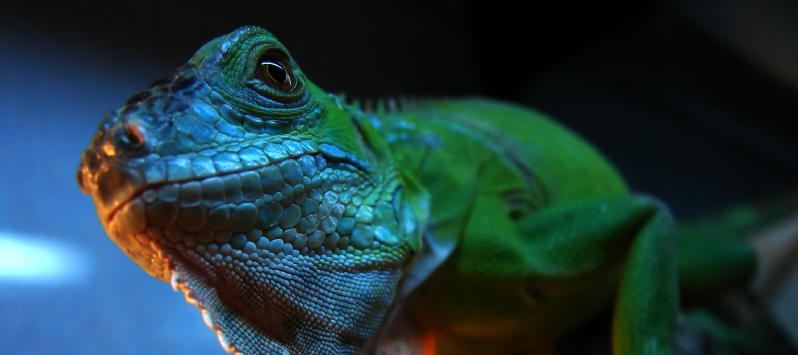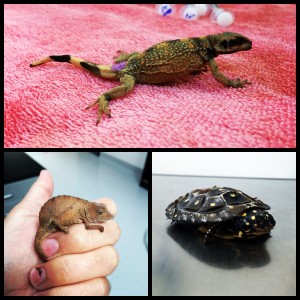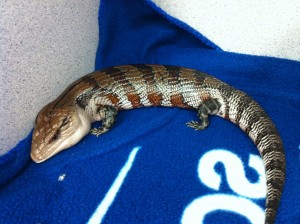By Stephen Cital, RVT, SRA, LAT
Reptiles are special species with special nutritional needs. Nutrition based illnesses such as metabolic bone disease (nutritional hyperparathyroidism and hypovitaminosis A) are common conditions seen in practice. Understanding a bit about reptile nutrition and physiology will likely help prevent these preventable conditions.
Metabolism: Reptiles are ectothermic creatures. Ectothermic, for those of you more familiar with warm-blooded species, means that the animal controls its body temperature by outside means. The sun or warm surfaces are the most common ways for reptiles to warm themselves, but in certain species continuous or rapid movement can also play a role. Reptiles as an ectothermic species have a variable metabolic rate based on their core temperature, speeding up when at their optimal temperature and slowing down at night or in winter when cold. In general reptiles have a slower overall metabolic rate, about 1/5-1/7 that of our mammal patients at a temperature of ~98.6 degrees Fahrenheit. Reptiles even can go from having an aerobic metabolism to an anaerobic metabolism depending on the situation, like strenuous activity or diving. Inter species and size effect metabolic rates like that seem in mammals. Smaller reptiles often have a quicker metabolic rate compared to larger species.
Reptile metabolic rates will also depend on the species diet. Are they a predator or an herbivore? Predatory species that seek out there food daily, like smaller insectivores, have a quicker metabolism to keep up appropriate gut function and activity levels. Ambush species like pythons that sit and wait for long periods of time actually can shut down their GI tract altogether to conserve energy for months at a time. Species that hibernate or go through periods of estivation also can slow their metabolic rates to extreme levels to conserve energy and rely on fat stored in the liver.
When the ambush species finally eats or the hibernation ends a metabolic rate can increase 7-17 times to allow for digestion or food seeking behavior.
Herbivore species gain a lot less energy from their food sources, but spend considerably less energy acquiring their nutritional demands.
*PetED ClientED factoid: Tortoises that hibernate should not lose more than 10% of their body weight after hibernating.
An advantage to being an ectothermic species is they do not waste energy maintaining their body temperature. If we were to compare the caloric demands of two species, take an insectivore species of birds for instance, the caloric intake for the bird in one day would last a reptile of similar size 35 days! This conservatory and efficient use of calories has allowed reptiles to survive in particularly harsh environments successfully for millions of years.
The Digestive System: The gastrointestinal tract in reptiles, like other animals, starts at the mouth. Turtle and tortoise species have a beak, compared to snakes and lizards that have teeth. Apprehension and mastication of food is variable among species since forelimbs are rigid or non-existent in some reptile species. The tongue in certain lizards can be quite muscular and used for food apprehension. Mastication is minimal, with large chunks of food being swallowed after aggressive shaking or tearing.
Snakes, on the other hand, swallow their prey whole. To safely swallow such large portions, reptiles have specially evolved oral secretory glands that function to lubricate the food moving down the esophagus. Some snake species have even more evolved secretory glands that inject venom into their prey to immobilize them before swallowing. This is crucial to prevent internal trauma from prey that can cause damage while passing down the esophagus.
Reptiles have a fairly kinetic jaw that can open wide for food consumption. Snakes, however, have a particularly kinetic jaw that allows it to essentially walk along the prey when being swallowed.
The esophagus in most reptiles can act as a storage unit for large prey until it is able to pass completely into the stomach. The stomach, as in mammals, contains hydrochloric acid, which not only aids in the breakdown of the food, but also kills live prey. Hydrochloric acid can also help decalcify bony material.
Herbivore species have an exceptionally large cecum and have a shorter GI tract compared to carnivorous species. They also have a longer digestion rate as they utilize hindgut fermentation to breakdown the cellulose into usable fatty acids after more digestible proteins are absorbed in the stomach and small GI tract. Digestion of plant material can take 50-60% longer in reptiles as compared to mammals for a few reasons. The GI activity will essentially stop during cool nights and nearly all the moisture content, as well as every possible nutrient, is extracted before elimination.
Speaking of elimination…the reptile GI tract ends with the rectum transitioning into a cloaca. The cloaca is a pouch-like anatomical feature that is crucial for last-ditch efforts in water absorption from the waste before excretion. The cloaca in a clinical setting is also a site of water absorption for ill reptiles. Soaking a reptile in a warm shallow bath will allow cloacal absorption as a parental method of hydrating a reptile.
Food selection: It is critical to fully research and consult a veterinarian that specializes in reptiles to implement a proper nutrition plan. Keep in mind, too, that reptiles being kept as pets have a significantly lower calorie requirement than their free-living cousins. Captivity will also decrease the incidences of estivation or hibernation.
Hospitalized patients that are ill or recovering from surgery have an increased caloric demand, up to 4 times! Likely, one may have to gavage feed these animals, as their willingness to eat will be poor. Fortunately, there are multiple nutrient rich diets, like those made by OXBOW, on the market for compromised patients. These diets are highly suggested over home prepared slurries of dog food and whatever else people get creative with.
Providing herbivore species (only around 3% of reptiles) with a variety of nutrient rich plant material is ideal. Dark leafy greens offer good sources of calcium and phosphorous (Kale has an excellent Ca:P ratio). Fruit in moderation is good for water absorption, but should be limited in fear of excessive weight gain and the animal choosing to eat only these more tasty options, inhibiting a healthy more wholesome diet.
Insectivore species are of particular interest of mine. Insects that are being fed to insectivores need to come from a credible source and not caught from the wild. Healthy insects mean a healthy reptile. Crickets are common and easy to acquire for insectivore species, but generally are low in calcium. Feeding the live crickets a calcium rich diet will aid in nutritionally enriching the insects prior to feeding to the reptile but high calcium diets for the crickets should be limited to 5 days. Some owners choose to dust their insects with calcium or other supplements prior to feeding, however the efficacy of this method is still undetermined.
Also, beware of feeding larval stage insects all the time as an entire meal. Larval insects are high in fat, needed to go through transformation into an adult insect. When feeding larval species (meal worms, wax worms) we must consider them as a fast food, full of unnecessary fat. These larval species can be used as treats or used for ill reptiles. I do find they are good for medicating reptiles with oral drugs by injecting the larva with an insulin or tuberculin needle. In all insect species, no matter what one chooses, proper husbandry for them is nearly as important as it is for your reptile.
For the larger carnivorous species, choosing a reputable prey supplier is also vital. Sick or emaciated prey should never be fed to reptiles. Many veterinarians would suggest feeding already dead prey species to captive reptiles. Live prey can cause significant trauma to the reptile pet during capture or if the prey is not consumed right away.
For fish eating reptile species, supplementation with Vitamin E and thiamin will likely be necessary, due to the breakdown of these nutrients during thawing or storage. When feeding a reptile food in their natural forms in not possible or desirable there are numerous commercially available options. One benefit of commercially available diets is their consistency of balanced nutrients. However, consulting with a reptile specialist is encouraged to find the best option for the particular species or reptile being fed.
Light sources are nearly as important as a balanced dietary plan. Whenever possible allowing access to natural sunlight is encouraged in an enclosure that can ventilate well and not get overheated.
If sunlight is not an option, light sources that emit ultra-violet B (UVB) wavelengths at 290-320nm and UVA 320-400nm will work. Often both wavelengths can be found at ideal levels in lights specially made for the reptile trade. Do not be fooled by lights that say “full spectrum”, read the entire label!
Lighting is crucial for normal behaviors like basking, reproduction and food seeking. Physiologically adequate lighting will keep the immune system healthy and allow proper conversion of Vitamin D so that metabolism of calcium can occur. A variety of lights may be necessary to produce a mosaic of heat levels in an enclosure and offer the reptile an ideal living situation.
Wrapping up: Currently, there are many different strategies for feeding reptiles and we now know enough about reptile husbandry to prevent many nutrition related illnesses. Educating oneself in proper husbandry and nutritional guidelines for every particular species one is working with is ideal. If long-term care is necessary, a dietary consult with a veterinarian that is suggested.
*If any of this information was useful or you would like to see similar content, “LIKE” the Pet ED Veterinary Education and Training Resources Facebook page and sign up on our website for our newsletter.
Exotic species are growing in popularity in every general practice. If you would like Stephen to come to your practice to help you expand your knowledge base in relation to these special creatures, fee free to contact him through contact form.




